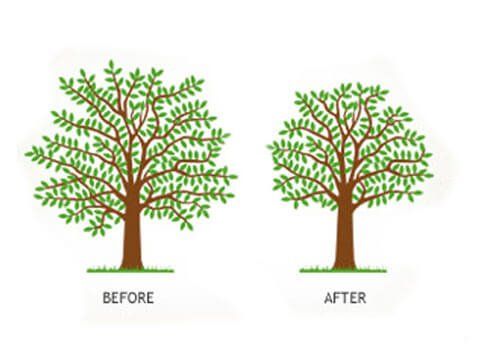What is Tree Pruning?
- By Fox Tree Services
- •
- 23 Apr, 2018
Pruning a tree is removing specific branches or stems to benefit the whole tree.
Why Prune a Tree?
Remove dead, damaged and diseased branches to help prevent insect & decay organisms from entering the tree.
Thin a dense canopy on a tree to increase air and sunlight, resulting in fewer disease problems.
Remove suckers & water sprouts to eliminate weak wood and provide more food and water for the tree.
Eliminate crossing branches to prevent damage caused by their rubbing against each other.
Weak or narrow crotches split apart as the tree grows older. Remove these crotches to eliminate breaking and tearing of wood.
Remove co-dominant leaders. Co-dominant leaders are 2 branches growing near the top of a tree that grow straight up and become equally dominant. Cutting off one allows the other branch to grow & become the dominant branch. This prevents the branches from splitting and tearing wood that is often a problem in heavy winds.
Safety
Correct pruning procedures create & maintain a strong tree structure, preventing safety hazards such as low growing branches and growth forms subject to storm damage near a sidewalk or driveway.
Maintain natural tree form
Often erratic or vigorous branches grow that change the growth habit of other branches, this results in a misshaped tree. Early removal of these vigorous branches maintains a natural tree form.
Stimulate or restrict growth
Pruning can stimulate growth in sparse areas of the tree. Pruning can also restrict growth where too much growth is undesirable.
When Do You Prune a Tree?
Dead, damaged, and diseased branches should be removed as soon as possible. Otherwise, the best time to prune is in late winter, early spring, just before the tree begins to open its buds. Some trees, such as maple and dogwood, will bleed sap at this time of year. This bleeding should not harm them. While pruning can be done anytime, it is always good to avoid hot dry periods and extreme winter cold. If you do prune trees after the leaves have opened, be sure to allow them to fully develop their leaves plus some additional time to recoup the energy they used.
How Do You Prune a Tree?
Getting Started
The first rule before a cut is made is to determine why and what is to be pruned. Start with a plan. Then decide what equipment is to be used. Most pruning tasks can be done with hand pruners, loppers and a pruning saw.
Hand pruners. There are 2 types of hand pruners, bypass and anvil. Bypass pruners cut like scissors. One sharp blade slides past another sharp blade resulting in a good clean cut. The cutting action of anvil pruners is one sharp blade cutting against a flat surface blade. This type of action tends to crush tissue on the underside of a stem. Bypass pruners are recommended because of the clean cut. Crushing opens up plant tissue to infection. Both types of hand pruners are made to cut wood ½ to ¾ inch diameter.
Loppers. There are also 2 types of loppers, bypass and anvil. Loppers have larger blades and longer handles that are designed to cut wood ¾ inch up to 1 ½ inch diameter. The bypass lopper is recommended.
Pruning saws. The new tri-edge folding saws are replacing the older bow saws. These saws quickly and easily cut wood up to 3” diameter.
How to Cut
The very act of pruning wounds the tree. When done right, pruning can help trees. When done wrong, it will harm them. Flush cuts and leaving a stub are two examples of improper pruning.
Trees do not ‘heal’ their wounds. When a branch is cut off it is gone, it doesn’t grow another branch. Trees ‘seal’ their wounds. When pruned right, a callus grows like a donut, starting at the edge and growing in until the callus covers the cut.
Inside the tree a chemical boundary is formed around the wounded area that compartmentalizes the wound. Compartmentalization limits any decay that may occur from wounding.
Flush cuts and leaving on stubs cause wounds that will not callus over or compartmentalize. The tree will begin to rot in these areas.
When pruning a branch off the tree’s trunk, knowing and locating the branch collar & branch bark ridge is very important. The branch collar is a swelling that forms around the base of the branch. (See figure.) The branch bark ridge is slightly raised, dark, rough bark that forms where the branch and trunk tissue meet. These are the areas on a tree that contain the chemicals that initiate the callus growth and the compartmentalization that protect the wound created by the cut.Cutting into these areas is unhealthy for the tree and should be avoided. When removing a large heavy branch, 3 cuts are necessary to avoid tearing into the branch collar.
Finally, don’t spoil your correct pruning job by coating the cut with tree paint or wound dressing. Many years of research indicate they do nothing to prevent decay and nothing to promote closure of the wound. If anything, they promote rot because they keep the wood wet long after a rain. And be sure not to take away too much of the tree at any one time.
More Post From Our Blog

Coppicing has been traced back to Neolithic times by archaeologists who have excavated wooden tracks over boggy ground made entirely of coppiced material.
There are written records, going back to at least 1251, which describe the value and type of material cut for woods in East Anglia. Coppicing can provide a constant supply of material for a wide variety of uses. The material is of a size which is easily handled. This was very important before machinery was developed for cutting and transporting large timber, when anything more than 20 miles from a large river could only be used locally. Through the 18th and 19th centuries, coppiced woodlands provided industrial charcoal for the smelting of iron, and bark from which tanning liquors were prepared.
However, by the mid-twentieth century coppicing was in rapid decline and many coppice woods were replanted with conifers, or simply neglected.
As qualified Trees surgeons, we have been carrying out tree felling in Cardiff and throughout South Wales for many years. Felling Trees safely requires us to survey the site and establish the best method to fell the tree and avoid damage to the surrounding areas. We are happy to offer our Tree Felling site surveys for free to all our customers, along with any appropriate advice.




